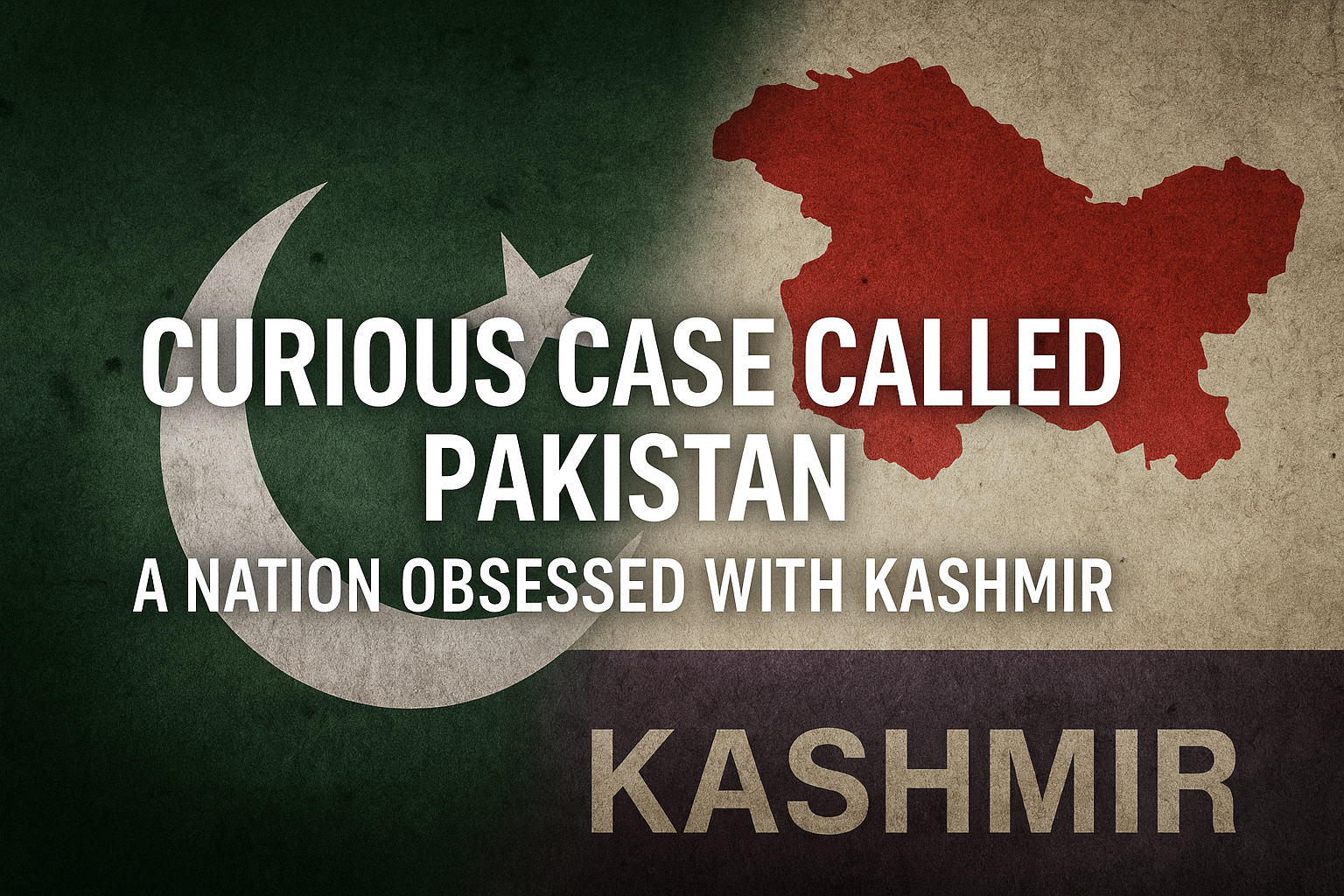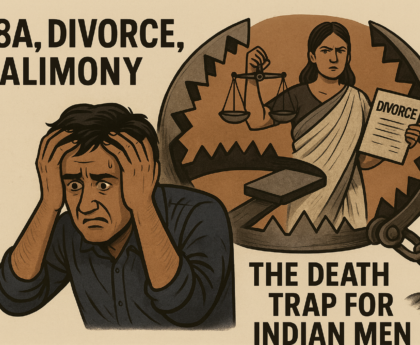The story of Pakistan since its birth in 1947 remains one of the strangest paradoxes in modern history. Nations that started their journeys around the same time — Japan rising from the ashes of World War II, Singapore transforming from a swamp into a financial powerhouse — are now shining examples of progress, stability, and prosperity. Pakistan, on the other hand, is grappling with economic collapse, political turmoil, and a society torn by extremism.
A Nation Obsessed With Kashmir
Perhaps no single factor has damaged Pakistan more than its obsession with Kashmir. What could have been a bilateral issue addressed diplomatically was turned into a cornerstone of Pakistan’s state policy. Every institution — politics, military, bureaucracy, even the education system — has been geared to nurture hatred against India and fantasize about Kashmir. This fixation has not only drained Pakistan’s resources but also prevented it from focusing on pressing issues like healthcare, literacy, industrialization, and employment.
Instead of developing a robust economy, Pakistan chose to nurture an identity centered around conflict. India moved forward — becoming the 4th largest economy and positioning itself at the center of global trade and diplomacy — while Pakistan remains stuck in an endless loop of confrontation.
Terrorism as a State Policy
Closely linked to its Kashmir obsession is Pakistan’s dangerous flirtation with terrorism as a tool of statecraft. By cultivating extremist groups, Pakistan hoped to bleed India “through a thousand cuts.” But the policy boomeranged. The fire that Pakistan lit spread within, consuming its own citizens. Today, Pakistan is one of the countries most plagued by internal bombings, sectarian killings, and terrorist attacks.
Even as ordinary people suffer, the military-intelligence complex treats these militant networks as strategic assets, unwilling to give up a tool they see as leverage. The result: a nation held hostage by extremism.
Begging Bowl Economy
While nations like Japan and Singapore invested in education, industry, and innovation, Pakistan has perfected the art of survival through aid. Its economy revolves around loans from the IMF, bailouts from China, emergency packages from the US, and lifelines from Gulf countries like Qatar and Saudi Arabia. Instead of building sustainable exports, industries, or world-class services, Pakistan has depended on handouts, mortgaging its sovereignty in the process.
Ironically, the same country with incredible potential in music, food, tourism, and sports has chosen to define itself by missiles, bombs, and military parades. Every dollar that could have gone into schools and hospitals has gone into weapons, leaving generations of citizens deprived.
India’s Contrast
What makes Pakistan’s failure starker is the contrast with India. Despite sharing a common history and challenges, India invested in institutions, democracy, and economic reforms. Today, India is respected as a peace-loving nation, attracting global investments and becoming an IT and innovation hub. Pakistan, on the other hand, sees threats where there are none. For all its paranoia, India has never posed an existential danger to Pakistan — yet Pakistan has built its identity around fear and hostility.
Pawn Between Superpowers
Pakistan’s geopolitical games have further eroded its sovereignty. On one side, it has aligned itself with China, welcoming massive investments through the China-Pakistan Economic Corridor (CPEC). On the other, it continues to depend on the US for military and financial support. This contradictory posture — pretending to play both sides — has only deepened mistrust.
China is no fool. It knows its investments in Pakistan are risky, and when push comes to shove, it will prioritize its own strategic interests. The US, too, sees Pakistan more as a liability than an ally. Yet Pakistan’s military leadership believes it can endlessly milk both, without realizing the costs.
A Nation Held Hostage by Its Military
Unlike most democracies, Pakistan’s military has always been the ultimate power. The generals dictate national policy, topple governments, and run businesses worth billions. While ordinary citizens struggle with inflation, poverty, and lack of healthcare, many retired generals relocate comfortably to the UK, USA, or Dubai with fortunes amassed from corruption. The country bleeds while its so-called protectors thrive.
As long as this structure remains, Pakistan’s priorities will not change. The welfare of its people will always come last, after weapons procurement, Kashmir rhetoric, and military luxuries.
Lessons Unlearned
Every blast, every loan default, every international embarrassment should have been an opportunity for Pakistan to reflect and change course. But instead, the country doubles down — more weapons, more terror, more rhetoric against India. Self-introspection is absent.
What Pakistan refuses to accept is simple: India is the bigger nation, economically and geopolitically. Competing through hatred and conflict is futile. True sovereignty and dignity can only come through economic self-reliance, education, stability, and peace with neighbors.
Below are 30 concise, evidence-backed facts showing the human, economic, environmental and institutional losses Pakistan has suffered (or risks suffering) that many analysts link to long-run state choices — notably heavy defence spending, use of militant proxies, recurrent bailouts, and governance weaknesses. Where figures are debated we have given ranges and cite reputable sources so readers (including Pakistani civilians) can see the evidence and judge for themselves.
Note: We used public sources (IMF, SIPRI, Reuters, SATP, Britannica, Stimson, ICIJ, etc.). Where estimates vary we have given ranges and the source for those ranges.
- Terrorism fatalities, 2000–2019: Pakistan recorded many thousands of deaths from terrorist violence in the 2000s and 2010s — SATP’s year-by-year table documents repeated spikes (e.g., 2007–2010 and 2014–2016). These totals run into the tens of thousands over the two decades. South Asia Terrorism Portal
- Cumulative human cost from internal conflict and militancy: Independent trackers and reports estimate that since 2000 Pakistan has lost tens of thousands of civilians, security personnel and insurgents to militant violence and counter-insurgency — a heavy long-term toll on families and labour. South Asia Terrorism Portal
- Partition and 1947 deaths (context): The 1947 partition violence that affected the territory that became Pakistan is estimated at 200,000 to 2,000,000 fatalities in scholarly and compendium estimates — a foundational human catastrophe that shaped politics. (Estimates vary widely across sources.) Every Casualty
- 1971 war and human losses: The 1971 conflict (East Pakistan → Bangladesh) produced extremely large human losses; published estimates range from hundreds of thousands up to millions (Bangladeshi sources often cite ≈3 million; independent studies give lower but still very large ranges). The war also ended with the surrender of ~93,000 Pakistani troops and a decisive geopolitical defeat for Pakistan. Wikipedia
- Kargil (1999) — military & reputational loss: The 1999 Kargil conflict ended in withdrawal and is widely regarded as a strategic defeat for Pakistan; Pakistani statements later acknowledged heavy troop casualties (former PM Nawaz Sharif cited ~4,000 Pakistani troops killed in some contexts). The episode damaged Pakistan’s military reputation and finances. Wikipedia
- Repeated IMF bailouts and financial vulnerability: Pakistan has turned repeatedly to the IMF (dozens of arrangements since 1958). Recent high-value programs (2019 EFF; 2023–2024 standby/EFF packages, and a large $7bn facility approved in 2024) show chronic balance-of-payments and debt problems. Frequent bailouts indicate structural fiscal weakness. IMF
- External debt and Chinese exposure (CPEC): Pakistan’s external debt burdens have ballooned in recent years; analysts estimate a large share of external lending and project finance comes from China (CPEC projects estimated in tens of billions), raising concerns about debt sustainability and repayment pressure. UN Trade and Development (UNCTAD)
- Military spending crowding out development: SIPRI and World Bank data show Pakistan devotes a large share of government resources to defence. High defence outlays relative to development budgets constrain spending on health, education and infrastructure. SIPRI
- Direct economic damage from terrorism & insecurity: International studies (e.g., IEP, World Bank analyses) show that persistent violence reduces GDP growth, investment, tourism and local business activity; Pakistan’s growth and foreign-direct-investment performance has been impaired by recurring security crises. Vision of Humanity
- Loss of tourism potential: Pakistan has rich cultural and natural tourism assets (mountains, heritage sites). Persistent insecurity, visa and image problems have kept inbound tourism far below potential, costing jobs and foreign exchange that could have been earned by the private sector. (See global peace / tourism analyses.) Vision of Humanity
- Floods and climate vulnerability amplify economic losses: Recent catastrophic floods (e.g., 2022 and large monsoon events into 2024–2025) have killed thousands, displaced millions and caused multi-billion-dollar losses to agriculture, industry and infrastructure — worsening public finances and poverty. Reuters coverage estimates billions in crop and infrastructure damage and large displacement. Reuters
- Manufacturing & export setbacks from disasters and insecurity: Floods and instability have damaged textiles, leather and agricultural supply chains (important export sectors), directly reducing export earnings and employment in export-oriented towns. Reuters
- Human development costs — education & health deficit: Years of insecurity and budget priorities have left Pakistan with persistent deficits in schooling outcomes, health coverage and human-capital investments compared with regional peers — reducing long-term growth potential. (World Bank / UN analyses on inclusion & violent extremism emphasize these links.) World Bank
- Refugee/IDP and humanitarian costs: Major conflicts and militant operations have produced waves of displacement inside Pakistan (IDPs) and refugee flows in earlier decades, which carry long-term social and budgetary costs. Al Jazeera
- Losses from militancy that “boomeranged”: Policy decisions to nurture or tolerate certain militant groups for strategic ends created blowback: groups turned inward or attacked Pakistani civilians and institutions, increasing civilian casualties and insecurity. (Scholarly and policy reports document instrumentalisation of militancy.) SIPRI
- Banking, investor confidence & currency pressure: Recurrent political/military crises and balance-of-payments stress have repeatedly depleted reserves, pressured the rupee, and led to exchange-control/dollar shortages that harm import-dependent industry and ordinary consumers. (IMF / Reuters reporting documents these cycles.) IMF
- Opportunity cost of arms vs. welfare: Every dollar allocated to defence (weapons, maintenance, nuclear deterrence costs) is a dollar not spent on schools, hospitals, rural electrification and sanitation — a long-run welfare tradeoff many analysts highlight. (SIPRI + World Bank analyses show the scale of defence spending relative to public budgets.) SIPRI
- Brain-drain and emigration: Periodic security crises, limited economic opportunity, and political instability have encouraged skilled migration, reducing the domestic talent pool and long-term productivity growth. (Migration and development literature documents these dynamics.) World Bank
- Sports, culture and soft-power curtailed: Security and political image issues have restricted Pakistan’s ability to host international sports and cultural events, hurting visibility, tourism, and related revenues. (Observed across international event cancellations and travel advisories.) Vision of Humanity
- Institutional weakness and repeated coups/interventions: Pakistan’s history of military rule and frequent civilian-military friction have weakened democratic accountability and slowed institutional reform needed to attract long-term private investment. (Historical analyses document military interventions and their long-term institutional effects.) SIPRI
- Featured cases of elite offshore wealth and accountability gaps: Global leaks (Pandora Papers, Panama Papers) and investigative reporting have linked many Pakistani political and business elites — including allies of political and military figures — to offshore assets and London property, raising corruption and accountability questions. ICIJ
- Military-run economic enterprises create market distortions: Investigations and NGO reports show that military-owned businesses and housing ventures (e.g., Defence Housing Authority and related entities) control valuable assets and may reduce transparency in the economy. This blurs public/private lines and can crowd out competition. Transparency International Defense
- Cost of proxy warfare on state credibility: Using proxies in neighbouring areas (Afghanistan, Kashmir) has periodically provoked international sanctions, travel restrictions and diplomatic costs that reduce Pakistan’s economic and political space. (CRS, SIPRI and policy analyses discuss the diplomatic fallout.) Congress.gov
- Repeated emergency spending on security: Large post-attack security operations, responses to suicide bombings and counter-terrorism operations consume emergency budgetary resources with limited long-term returns for civilian welfare. (SATP and government security spending data illustrate recurrent spikes.) South Asia Terrorism Portal
- Loss of life from cross-border & LoC skirmishes: Periodic cross-LoC shelling and incidents have killed civilians and soldiers on both sides and depressed local economies in border districts — harming livelihoods and creating intergenerational trauma. (Conflict trackers and news archives document these incidents.) Council on Foreign Relations
- Reputational cost to exports and business partnerships: Persistent instability and governance concerns make multinational firms cautious; trade and investment partnerships that could create jobs are harder to secure at scale. (Investment analyses tie country risk to FDI flows.) World Bank
- Public-health setbacks from conflict & displacement: Conflict and disaster (floods, displacement) strain public health systems, increase infectious disease risk and reduce life expectancy gains that would otherwise come from development spending. (Humanitarian and WHO reports on displacement/health impacts.) Reuters
- Education & radicalisation feedback loop: Low schooling and limited economic opportunity in some regions have been exploited by extremist recruiters; weak education outcomes thus functionally add to insecurity and reduce future economic productivity. (World Bank/UNDP work on VEO drivers supports this link.) World Bank
- Economic shocks magnified by reliance on debt and aid: Recurrent dependence on external finance (IMF packages, bilateral loans) leaves Pakistan vulnerable to conditionality, market volatility and creditor leverage — limiting policy autonomy and long-term planning. IMF
- Aggregate “peace dividend” foregone: Studies that compare similar countries show that the economic value of peace — higher investment, tourism, exports and disposable income — is often many percentage points of GDP. Pakistan’s security and strategic choices have therefore likely cost it several percentage points of annual growth over decades compared with a more peace-oriented path. (IEP / economic-peace literature.) Vision of Humanity
How many people died in conflicts between India and Pakistan (approximate)?
- Partition 1947 (affecting future Pakistan territories): estimates vary widely — ≈200,000 to 2,000,000 total deaths in partition violence (scholarly debate; extremely wide range). Every Casualty
- 1947–present Indo-Pak wars and skirmishes: multiple conventional wars (1947–48, 1965, 1971, 1999 Kargil) plus many border clashes — cumulative military and civilian deaths across all wars are in the tens to low hundreds of thousands, depending on what episodes are counted and which estimates are used. (Different conflicts have different accounting standards; see war-by-war citations.) Wikipedia
- 1971 alone: civilian casualty estimates in the literature range from hundreds of thousands up to 3 million depending on source and methodology (Bangladeshi official figures vs. independent research). That single year dominates the casualty statistics for India-Pakistan conflict history. Wikipedia
Bottom line: there is no single agreed “one-line” death toll for India–Pakistan conflicts; credible source ranges show very large human losses in some episodes (notably 1971) and thousands killed in others (Kargil, 1965, 1947 partition waves, cross-LoC incidents, and ongoing low-level violence). Wikipedia
Major defeats / episodes often cited by analysts
- 1971 loss and the birth of Bangladesh — strategic and territorial defeat; massive human cost and surrender of ~93,000 Pakistani troops.
- Kargil 1999 — Pakistani forces were withdrawn under international pressure; widely described as a defeat that cost lives and prestige.
- 1965 war — heavy casualties on both sides; broadly viewed as a military stalemate but costly for Pakistan.
- 2016 “surgical strikes” and cross-LoC escalation — India publicly reported strikes on militant launch pads across the LoC; Pakistan disputed details but the incident damaged Pakistan’s strategic posture.
- Feb 2019 Balakot / subsequent aerial clash: India conducted an airstrike into Pakistan-administered territory (Balakot) in February 2019 after the Pulwama attack; Pakistan and India offered competing casualty and success claims — the episode was unprecedented since 1971 in that it involved airstrikes across the Line of Control and an aerial engagement. Analysts view it as an erosion of the old restraint and a reputational blow to Pakistan in some narratives.
- The Pahalgam attack in Jammu & Kashmir was a major terrorist strike in which heavily armed militants targeted civilians, resulting in significant casualties and widespread outrage across India. The attack was traced back to Pakistan-based terror groups, once again highlighting the long-standing issue of cross-border terrorism. In response, the Indian Air Force (IAF) carried out a precision strike on Pakistani military-linked infrastructure across the Line of Control. This was a significant departure from past practice, as India directly targeted facilities linked to terrorist training and support inside Pakistan. The strike sent a clear signal that terrorist attacks on Indian soil would invite direct retaliation at the source, not merely defensive operations within Indian territory. The action demonstrated India’s growing willingness to reshape deterrence equations with Pakistan, reinforcing that safe havens for terror infrastructure would not be tolerated. For Pakistan, the incident was both a military setback and a diplomatic embarrassment, as it highlighted its continuing role in sheltering militant outfits.
Short reading guide for Pakistani civilians who want to verify these facts
- Terrorist-casualty data: check the South Asia Terrorism Portal (SATP) fatality tables. South Asia Terrorism Portal
- Debt & IMF programs: IMF country pages and Reuters/AP reporting list program sizes and disbursement timelines. IMF
- Military expenditure: SIPRI fact sheets and the SIPRI military expenditure database show defence budgets and trends. SIPRI
- Major conflicts and historical casualties: Britannica, academic studies and major investigative reports (e.g., on 1971) provide detailed, sourced accounts of each war. Encyclopedia Britannica
- Corruption/offshore wealth investigations: ICIJ (Panama Papers, Pandora Papers) and reputable press (Guardian, Al Jazeera, Dawn) document offshore holdings and high-profile cases. ICIJ
In a Parallel Universe
A thoughtful, big-picture, and totally suitable for a short quantitative thought experiment. We will give a clear, transparent estimates (with the assumptions spelled out) so Pakistani civilians can see the scale of what might plausibly have been gained if Pakistan had followed a very different development path.
We will show two simple, complementary ways to estimate “what could have been”:
- Benchmark per-capita approach — assume today Pakistan had the same current per-capita income as a comparator (China, Japan, South Korea).
- Growth-rate gap approach — assume Pakistan had sustained a higher long-run growth rate (illustrative scenario) and compound that advantage over decades.
We have used a single population assumption for clarity: Population = 240,000,000 (240 million). We have used a conservative current nominal GDP baseline for Pakistan of about $350 billion (i.e., $0.35 trillion) as the “actual today” number for comparisons.
1) Benchmark per-capita approach (today’s snapshot)
Multiply population × comparator per-capita income to get hypothetical GDP today.
Benchmarks used (per-capita, illustrative):
- China per-capita ≈ $12,800
- South Korea per-capita ≈ $35,000
- Japan per-capita ≈ $40,000
Calculation (population × per-capita → GDP in trillions USD):
- China-style: 240,000,000 × $12,800 = $3.072 trillion.
— Difference vs actual $0.35T: ≈ $2.72 trillion more today. - South Korea-style: 240,000,000 × $35,000 = $8.40 trillion.
— Difference vs actual $0.35T: ≈ $8.05 trillion more today. - Japan-style: 240,000,000 × $40,000 = $9.60 trillion.
— Difference vs actual $0.35T: ≈ $9.25 trillion more today.
Interpretation:
If Pakistan had achieved per-capita income similar to China’s today, its economy would be roughly $3.1T instead of roughly $0.35T — a gap of about $2.7T in annual GDP. If it had reached South Korea or Japan per-capita levels, the gap widens to $8–9 trillion.
2) Growth-rate gap approach (compounding advantage over decades)
This method asks: if Pakistan had consistently grown faster each year for many decades, how big would GDP be today?
Simple illustrative scenario:
- Suppose Pakistan’s long-run actual average real growth was ~3% per year.
- Suppose it could instead have averaged 6% per year for the same period — a 3 percentage-point higher sustained rate.
- Compare outcomes after 50 years (a mid-to-long horizon).
Growth multiplier ratio after 50 years = (1.06 / 1.03)⁵⁰ ≈ 4.2018.
So the “6% path” economy would be ≈ 4.20× the size of the “3% path” economy, all else equal.
Applying that to today’s actual GDP baseline:
- Actual today ≈ $0.35T.
- Hypothetical (6% vs 3% for 50 years): 0.35 × 4.2018 ≈ $1.471 trillion.
- Difference ≈ $1.12 trillion higher than today.
Interpretation:
A sustained extra 3 percentage points of annual growth for ~50 years could plausibly lift Pakistan from ~$0.35T to ~$1.47T today — an extra ~$1.1T of annual output compared with the low-growth path. (If the growth advantage were larger, or sustained longer, the multiplier and the gap would grow dramatically.)
Rough estimate of cumulative lost output over decades
Annual-gap numbers are useful, but many people want a sense of cumulative foregone output (the total “wealth” Pakistan didn’t produce because of lower growth / wrong policy choices).
A quick conservative framing:
- If Pakistan’s GDP today could be $3T (China per-capita benchmark) rather than $0.35T, that’s ~$2.7T of missing annual output today.
- Repeating a multi-trillion annual difference across a decade is literally tens of trillions of dollars in foregone production (e.g., $2.7T × 10 years = $27T).
So a plausible, conservative statement is:
- Pakistan has foregone — cumulatively over recent decades — economic output measured in the low-to-mid tens of trillions of US dollars, under realistic “if-we-had-grown-like-X” scenarios.
- The exact number depends on the comparator and the time window; using a China-per-capita comparator yields lower tens of trillions over multiple decades; using Japan/South Korea comparators yields substantially higher totals.
Important caveat: cumulative tallies are very sensitive to the time frame and the benchmark growth path chosen. The “tens of trillions” figure is meant to communicate scale, not a precise accounting ledger.
What could have happened if Pakistan had behaved like Japan or China?
Qualitatively and quantitatively:
- If Pakistan had built institutions, education, and industrial policy like South Korea/Japan: per-capita incomes could be in the tens of thousands of USD today. With 240M people, that translates into $6–$10 trillion economies (roughly the South Korea / Japan per-capita scenario above gave $8–9.6T). Economies of that scale would mean far higher living standards, markedly different public infrastructure, and global economic/soft-power influence.
- If Pakistan had replicated China’s reform-led export-driven model over the last 40 years: a plausible today-GDP range is $2–4 trillion, depending on productivity and integration. That would still be an order of magnitude larger than present.
- Social effects: larger GDP → more tax revenue → better schools, health, sanitation, and less vulnerability to propaganda and instability. Education and professional opportunities would reduce radicalization and brain-drain. Tourism, culture, music, and sports would become exportable soft power and jobs.
Key uncertainties & assumptions
- Baseline GDP and population: We have used $350B and 240M for clarity. Small changes in these numbers alter results proportionally.
- Per-capita benchmarks: We have used round figures for comparator per-capita GDPs to keep results understandable.
- Growth-rate comparisons: Real growth sustained over decades compounds hugely — small annual gaps become massive cumulative differences. The illustrative 3% gap over 50 years was chosen to show that effect; actual gaps, time windows and starting points matter.
- Policy versus path dependency: Economic outcomes depend on many factors — institutions, human capital, geopolitical stability, global demand, governance, rule-of-law, and macro stability. The numbers above are “if everything else matched the comparator” thought experiments.
Plain summary (big takeaways)
- Today’s Pakistan (~$0.35T) could plausibly be a multi-trillion dollar economy under alternative, peace-and-development-oriented policy choices.
- Per-capita benchmark: matching China’s current per-capita would put Pakistan near $3.1T; matching South Korea/Japan would put it in the $8–10T neighborhood.
- Growth gap scenario: a sustained extra 3 percentage points of real growth for 50 years could plausibly raise today’s GDP from ~$0.35T to ~$1.47T (an extra ~$1.1T of annual output).
- Cumulative forgone output over decades under realistic assumptions is likely in the low-to-mid tens of trillions of dollars — a scale that shows how enormously costly low growth, conflict, and misdirected priorities can be.
The Road Ahead
Will Pakistan ever learn? On paper, it has all the ingredients to succeed — a young population, rich culture, strategic geography, and natural resources. But as long as its politics and institutions remain hijacked by the military-industrial complex and poisoned by an obsession with Kashmir, the future seems bleak.
For Pakistan, survival now means abandoning terrorism, ending the Kashmir fixation, and focusing on its citizens. It means turning its music, food, sports, and tourism into global strengths instead of exporting instability.
But given history, this sounds like wishful thinking. The “curious case called Pakistan” remains a tragic tale of opportunities squandered and a nation self-destructing in pursuit of illusions.
#India #Pakistan #Kashmir #Media #InternationalMedia #NeutralOdishaNews #China #US #Russia #UK #INDvPAK #indvspak2025 #Sports #Terrorism #TerroristState #Terrorists #Balochistan @PMOIndia @narendramodi @adgpi




